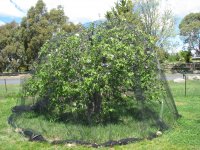Now that everyone is in “cider mode” I thought I would try to see if someone can shed some light on what this apple is.
Attached are pics of an apple, the tree and the blossoms. The apple pic is a few years old but the others were taken today (Spring) but probably don't help too much... a tree, is a tree, is a tree!
The best guess so far is a Gravenstein (at least that is what we call it), but the tree was here when we bought the place and using an apple identification web site doesn’t really help because there seems to be a lot of apples with similar characteristics. It would be quite a large tree if I didn’t cut off the watershoots and prune it to a reachable height occasionally
They are typically quite large apples at around 2-1/2 inches (7cm) and weigh 5oz (150g) with a juice SG over 1.060 and pH 3.5. It has a “cooking apple” taste, but is also quite good to eat with just a touch of tartness. SWMBO uses them for pies, sauce, chutney, etc.
Of more importance, I use it a lot for a cider base where it blends well with Pomme de Neige or Cox’s Orange Pippin. A hundred or so of the apples usually give me more than a gallon of juice.
So, the name isn't all that important because for me it is a “good” basic cider apple, but it would be good to know what type it is if anyone has any clues. I like to list the apples on the back label when I bottle.



Attached are pics of an apple, the tree and the blossoms. The apple pic is a few years old but the others were taken today (Spring) but probably don't help too much... a tree, is a tree, is a tree!
The best guess so far is a Gravenstein (at least that is what we call it), but the tree was here when we bought the place and using an apple identification web site doesn’t really help because there seems to be a lot of apples with similar characteristics. It would be quite a large tree if I didn’t cut off the watershoots and prune it to a reachable height occasionally
They are typically quite large apples at around 2-1/2 inches (7cm) and weigh 5oz (150g) with a juice SG over 1.060 and pH 3.5. It has a “cooking apple” taste, but is also quite good to eat with just a touch of tartness. SWMBO uses them for pies, sauce, chutney, etc.
Of more importance, I use it a lot for a cider base where it blends well with Pomme de Neige or Cox’s Orange Pippin. A hundred or so of the apples usually give me more than a gallon of juice.
So, the name isn't all that important because for me it is a “good” basic cider apple, but it would be good to know what type it is if anyone has any clues. I like to list the apples on the back label when I bottle.








![Craft A Brew - Safale BE-256 Yeast - Fermentis - Belgian Ale Dry Yeast - For Belgian & Strong Ales - Ingredients for Home Brewing - Beer Making Supplies - [3 Pack]](https://m.media-amazon.com/images/I/51bcKEwQmWL._SL500_.jpg)





















































